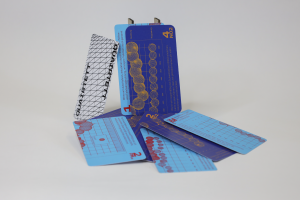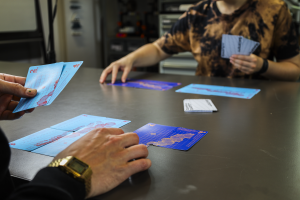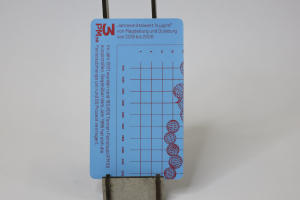Public Awareness
Within the student project “awAIReness” a team of eight industrial design students from Magdeburg, seven computer science students from Skopje, two professors, and two researchers explored ways to communicate air quality data in public spaces through an iterative Design Science Research process. This approach aimed to enhance the understanding of air quality by presenting information interactively, creatively, and artistically. The design process included the phases Explore, Imagine, Inform, Create, and Test. The project resulted in six different concepts.
Pollution Booth
This photo booth from Ide Wilenius and Mariele Goeldner displays the current air pollution of the city where the photos are taken on the printed images. PM10 particles are made visible on the pictures in form of colorful confetti. Additionally, terms related to air pollution are explained on the back of the photos. The project was developed through brainstorming, extensive research, and user surveys. The goal was to convey information about air pollution in a playful way. For this purpose, a measurement station in Magdeburg was considered, and information on particulate matter pollution was obtained. The installation encourages people to engage more with air quality and its effects.
Visible Particulate Matter
Jessen Eggert’s VR application visualizes air pollution within the city of Magdeburg and provides information about various air pollutant particles. The objective is to virtually locate the area with the lowest pollution levels. This playful, visual experience aims to make air pollution more visible and tangible. The realistic, real-time experience with interactive components is designed to encourage users to advocate for better air quality. The real-time data is sourced from the open-source platform Pulse.Eco and transferred via an API (Java Spring Boot) to the Processing software, which maps pollutant measurements to their respective locations on the map. These measurements are then displayed as virtual particles in the Unreal Engine. The VR application is particularly effective in visualizing otherwise invisible air pollutants directly at urban locations where they are present at that time.
End Game
This “Super Mario” alike video game from Layan Siyam for children is designed to help them learn more about air pollution, its causes, and measures to combat it in a playful manner. At the same time, it aims to change behaviors for a generation that will be even more affected by air pollution than the current one. Children are also more susceptible to the effects of air pollution than adults and can be informed about it early on through the game. The game conveys information about behaviors to reduce risk. Instead of removing mushrooms, the avatar transforms cars into bicycles and CO2 clouds into fresh air. By jumping on the causes of air pollution, they are combated, and the air is cleaned. The interactive click prototype and the character design were created with Adobe XD.
Air Where
Air Where is a speculative future scenario designed by Bennex Ling that immerses viewers in a world plagued by severe air pollution. Against the backdrop of a future where breathing masks and other aids might become indispensable for healthy respiration due to dangerously high pollution levels, “Air Where” functions as a navigator, guiding individuals to locations where they can still breathe freely without health risks. The speculative design serves as a warning to today’s population, which is why the scenario is set in the year 2050. The design, together with thorough research, draws on scientific findings that offer a realistic prediction of future air quality. Part of this narrative is a tangible prototype out of silicone and scoby to best simulate the experience of skin. It is equipped with vibration motors controlled by an Arduino that navigate the user in the right direction using different vibration patterns and provide discrete distance information. This vision of the future aims to leverage users’ sense of shock to motivate them into taking potential countermeasures.
Breathe
The interactive panel by Louise Pessel and Cassidy Sophie Gietz is designed to raise awareness of air pollution in public spaces. The artwork in the background and the current air pollution at the location are visualized in the foreground through bubbles. Touching individual bubbles reveals information about specific pollutants. As more vehicles pass by, the artwork becomes increasingly obscured by bubbles. For the small-scale functional prototype, the screen was divided into four vertical segments. When the battery-operated car (computer mouse) drives past the screen, the amount and color of pollutants projected onto the screen changes based on the y-value of the mouse using Visual Studio Code.
QUAIRTETT
The card game QUAIRTETT uses graphics to inform players about air pollution pollutants, their impacts, and distribution in the two German cities of Magdeburg and Duisburg. Each quartet presents an infographic detailing the pollutants in these cities and their spread. Through eight quartets, players can discern the connections between the causes, distribution, and effects of air pollution. The goal is to motivate players to engage more actively in air quality issues and to foster communication about it. In addition to its entertainment value, the quartet game serves as an educational tool on air pollution, placing QUAIRTETT in the category of Serious Games, which combine gameplay with educational, social, health, or economic themes. The biggest challenge for the creator, Valerius Weyer, during the development process was to condense as much information as possible onto the game cards while maintaining an appealing design. The prototype quartets display the annual average values of pollutants between 2000 and 2018, focusing on sulfur dioxide (NO2) and particulate matter (PM10). If the project were to continue, user surveys would be conducted to evaluate the game and implement feedback.



BIBLIOGRAPHY
Peffers, K., Tuunanen, T., Rothenberger, M. A., & Chatterjee, S. (2007). A design science research methodology for information systems research. Journal of management information systems, 24(3), 45-77.

